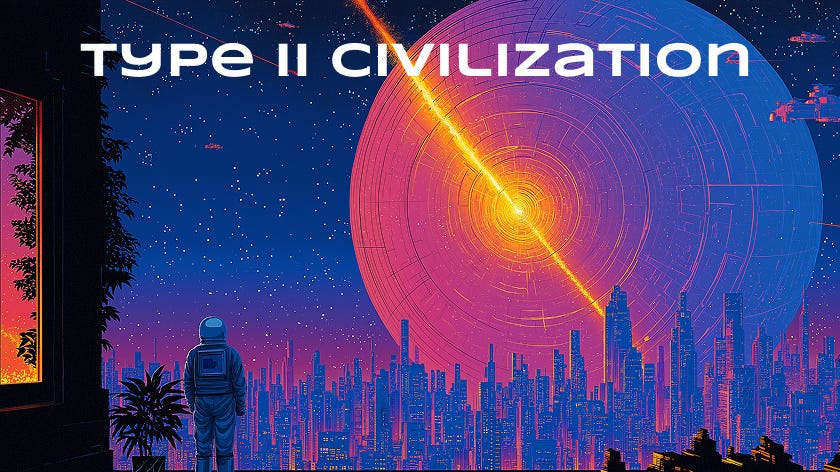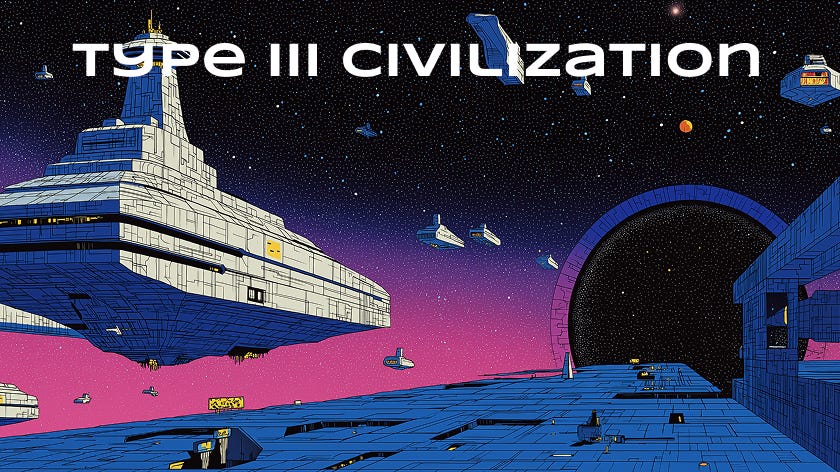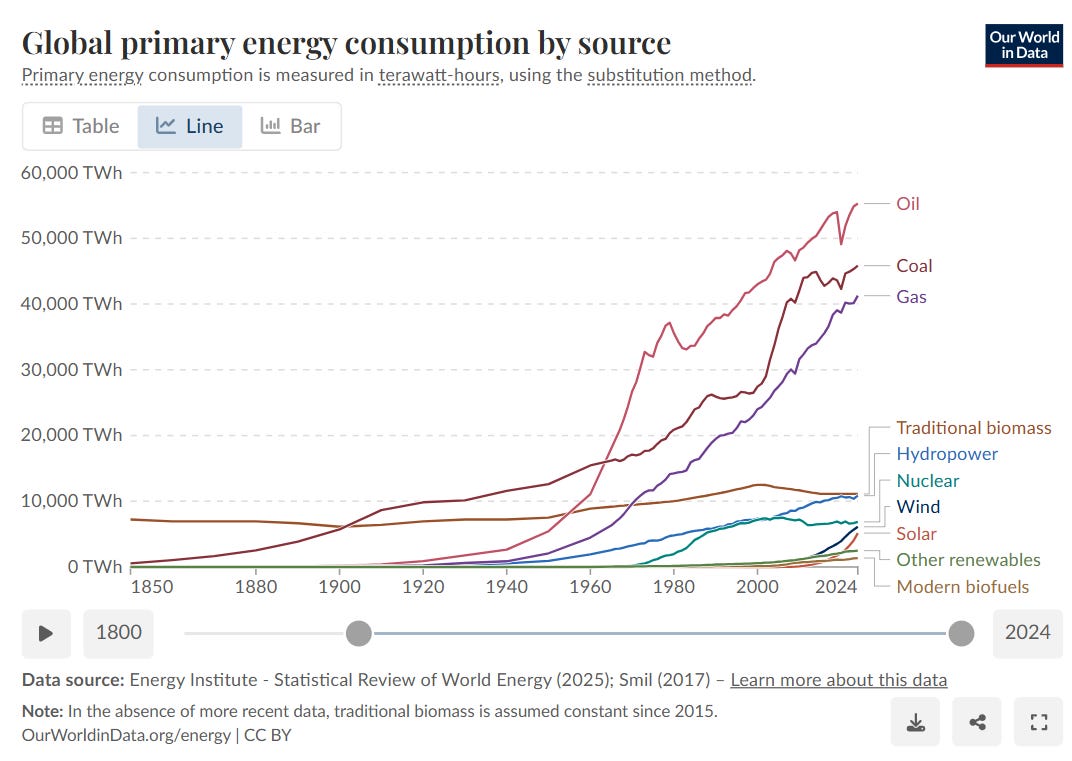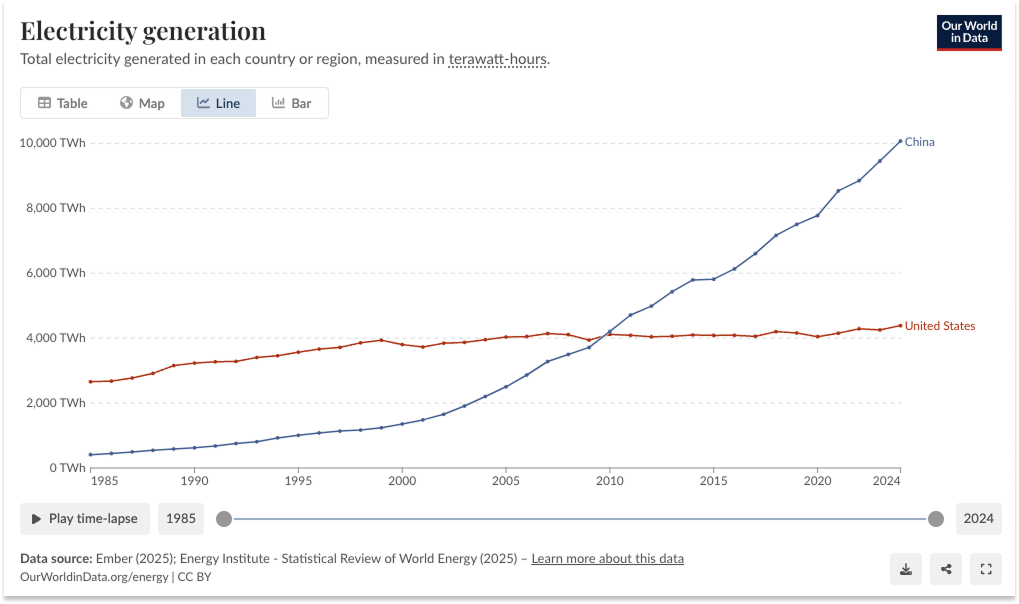Ooching Up the Kardashev Scale
And Why Tech Bros Won't Shut the Hell Up about It
Welcome to Words with Wynn! If this is your first time perusing my content and you’d like more of my weekly musings, subscribe below:
If we lurk the same corner of tech twitter, you probably see some techno optimist invoking the Kardashev Scale about once a week. To some, it’s become the ultimate arbiter of progress to be climbed with a religious zeal. We inhabit a godless postmodern hellscape, thus harnessing the entropy of the universe is a calling to transcend our meager toils. The idea is part and parcel of the Effective Accelerationism (e/acc) movement; a philosophy defined by “... embracing the thermodynamic imperative of the universe to accelerate progress, intelligence, and civilization” in pursuit of a “post-scarcity technological utopia”. Pretty cerebral stuff.
If e/acc is a cult, Beff Jezos is the prophet, and the Kardashev Scale is its gospel.
Simply, the Kardashev Scale is a measure of a civilization’s progress as defined by its ability to harness energy. It was first proposed in 1964 by Soviet astronomer Nikolai Kardashev as a framework in the search for other civilizations in the universe, and it’s comprised of a few broad categories:
A Type 0 civilization (added later by Carl Sagan) has harnessed about as much terrestrial energy as a few dozen campfires. Barely even to the starting line. On a galactic scale, humanity is in this neighborhood.
A Type I civilization is able to access all the energy available to its planet and store it for consumption. This could include resources like fossil fuels, wind, geothermal, and nuclear – but realistically, it means capturing all of the energy hitting a planet from its parent star (in Earth’s case, the sun), which produces orders of magnitude more than all terrestrial resources combined.
A Type II civilization can directly consume a star's energy, most likely through the use of a Dyson Sphere or some similar megastructure. This level of sophistication would imply mastery over interplanetary travel, off-world manufacturing, and engineering on a scale scarcely comprehensible to us today.
A Type III civilization is able to capture all the energy emitted by its galaxy, and every object within it, such as every star, black hole, etc. Past this point is when we’ve really entered deep sci-fi territory. If “any sufficiently advanced technology is indistinguishable from magic”, a civilization at this scale would likely look like gods to us.
Unfortunately for humanity, we haven’t even cusped level I yet. We’re barely a speck of dust on the universal stage. Most futurists place us around Type 0.7 (aka Type 0), and project that we ought to be able to climb our way to level I in the next hundred years or so. In technical terms, total human energy consumption is about 2 × 10¹³ watts, and Type I is reached at ~10¹⁶ . Each leg up thereafter goes by orders of magnitude (Type II ~10²⁶ watts, Type III ~10³⁶ watts).
Overintellectualizing aside, the Kardashev Scale is useful for its simplicity. It distills all progress down to a single tangible metric: energy consumption.
Of course, by this yardstick, we’re still practically cavemen burning twigs…
Yet with the launch of the AI arms race, this may be subject to change. The biggest AI story besides the breathtaking advancements of the tech itself has become the greed with which it demands power. The chart of the hour recently was the insane explosion of data center construction for our AI overlords (soon displacing new builds to house our corporate drones):

The second order effects of which are starting to show:
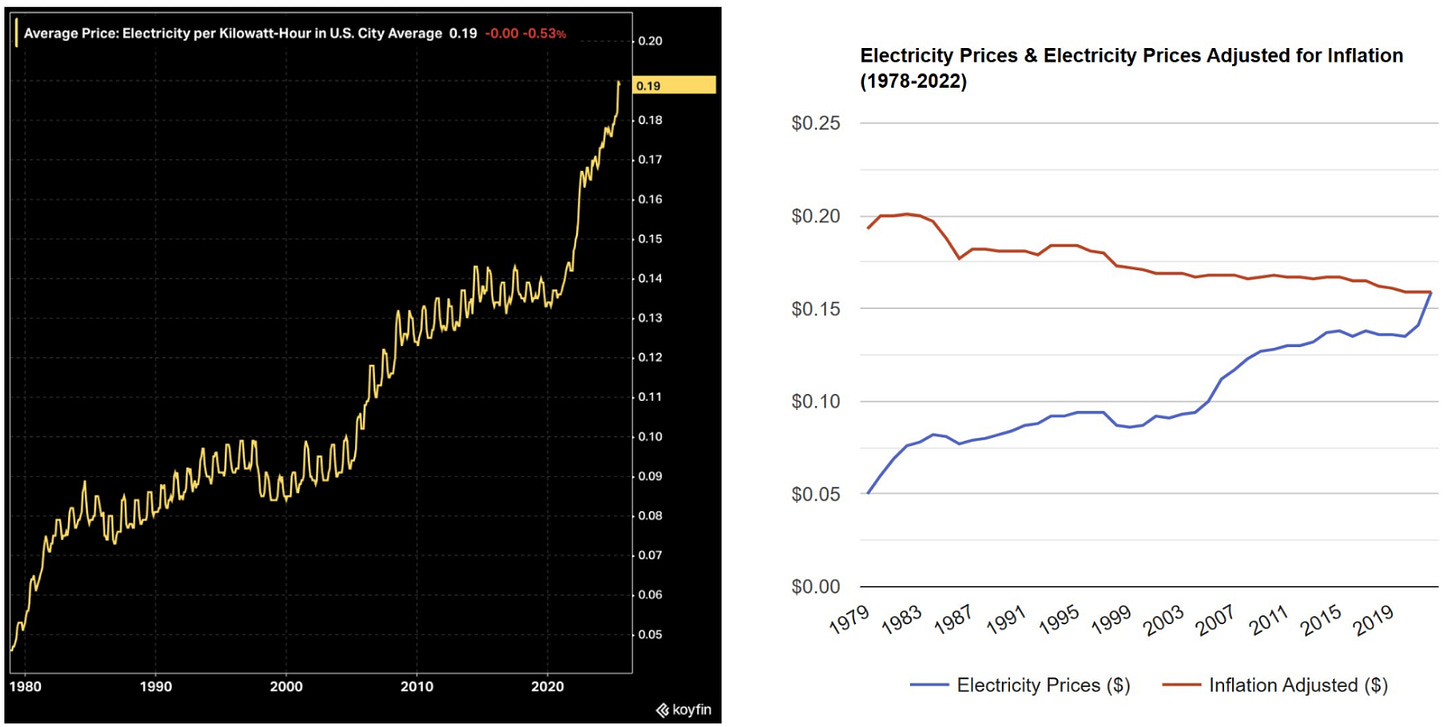
And these ideas are important. Power is important.
He who controls the compute may control destiny…
But all is lost without the power to fuel your intelligence and turn that into dexterity. We may have found a way to conjure intelligence at scale, but that’s really the combined resources of silicon and electricity. We’re making rocks speak, but you need the thinky juice to do it.. And our nearest competitor has bet accordingly:
A couple of years ago, Isaiah Taylor, the founder of nuclear company Valar Atomics, told me something that’s stuck in my head ever since:
There are only really three pillars to anything around us, as far as consumable goods. We've got energy, intelligence, and dexterity.
I would generalize “dexterity” to “action.” Everything we see around us, and will see around us in the future, is the result of the potential to do work (energy), the capacity to decide what to do and how (intelligence), and the ability to manipulate matter (action).
In economic terms, energy, intelligence, and action are strong complements in the production of anything.
And in the immortal words of Joel Spolsky, "Smart companies try to commoditize their products’ complements.”
America is, implicitly or explicitly, making a bet that whoever wins intelligence, in the form of AI, wins the future.
China is making a different bet: that for intelligence to truly matter, it needs energy and action.
If you control energy and action, making intelligence abundant strengthens your position.
After catching up to America in electricity generation in just 2010, China now generates 2.5x as much electricity as we do.
- Packy McCormick, The Electric Slide (Not Boring)
This extends beyond AI as well though, as energy accessibility is one of the defining features of advanced nations:
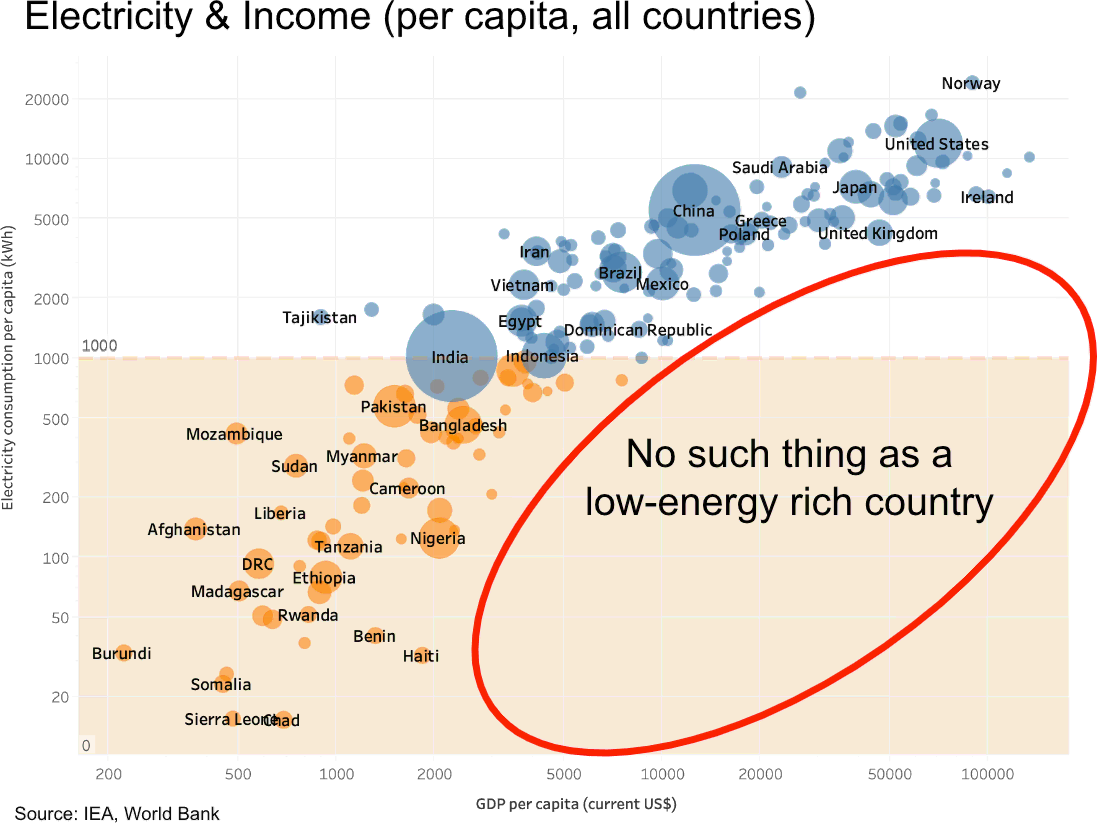
One can debate if the tail wags the dog above, but the one thing that isn’t up for debate is the freedom afforded by cheap energy:
“Oh, we’re running out of clean water, but it’s too expensive to desalinate!”
Not with infinite energy.
“We don’t have enough arable land!”
Scale your vertical farms and their 24/7 grow-lights.
“But these advanced industrial processes simply aren’t economic!”
Problem solved when your largest cost center goes to zero.
Many of our greatest thinkers and tinkerers recognize this. The might of American AI and domestic reindustrialization will depend in no small part upon our access to abundant energy. Investors have awoken to this truth and are pouring millions of dollars into moving the ball forward.
Hence, so many cool startups working to ooch our way up the Kardashev Scale.
Two themes in this narrative that have captured my attention are the nuclear renaissance and extraterrestrial solar.
Short term power demands are mounting. Without major breakthroughs in efficiency, the power consumed in running the world’s most advanced AI models will soon rival that of entire nations. This is compounded by the consistency with which data centers need power as well. Grid scale battery farms continue to advance, but data centers generally skew away from wind or solar toward less clean sources of power for lack of this kind of infrastructure (MIT Tech Review). But what energy source has a small footprint, low emissions, 24/7/365 output, and multiple decades of data proving its safety?
Enter: the Nuclear Renaissance.
I casually started following the radioactive vibe shift in the fall of 2023, just before Packy launched his nuke-pilled podcast series Age of Miracles that really drew me in. Those were the ‘early’ days of ChatGPT’s meteoric rise and, although AI was gaining consumer attention, the arms race of hyperscalers hadn’t really commenced yet. Global policy was just starting to shift back toward nuclear. Proponents were optimistic about the regulatory environment under the new administration as momentum began building, uranium prices started rising, and more startups were launching.
But 2024 was really a watershed year for the industry as global adoption accelerated:
And it feels like we’ve hit a domestic inflection point in 2025:
So, we seem to have identified our next tick up the Kardashev scale as fueled by nuclear technologies. And with the vibe shift in full swing, investors have poured capital up and down the stack, with small modular reactor (SMR) companies alone receiving over $1.5B in funding in 2024:

In the near-term, we should see next generation reactors (SMR pods like Aalo’s) coming online in the late 2020’s. Regulatory loosening is certainly speeding deployment, and I could potentially see a world where this is accelerated further if power demands continue to go exponential. You’d think those AI gigabrains would find some power efficiency breakthroughs as costs become prohibitive, but we shall see. Either way, SMRs only fill the gap in a few years. Forecasts for viable fusion are (optimistically) targeting the early 2030s, and even that likely wouldn’t be scaled commercial viability.
Plus, as I referenced above, a true Type I civilization ultimately would require vastly more power than means like terrestrial nuclear will even be able to provide, assuming constraints around total uranium availability etc. This eventuality has led some founders to wonder how we squeeze more juice out of the only place in our solar system that’s solved fusion already… the Sun.
Ra is absolutely cookin’. But beyond our current solar arrays, how do you capture more of that sauce?
Two words: Space Lasers.
Aetherflux is easily the craziest startup I’ve found recently. Founded by Baiju Bhatt (co-founder of Robinhood), the team is launching an array of satellites into Low Earth Orbit (LEO) in order to gather uninhibited solar power and beam it back to earth. You heard that right.
“The idea is crazy. Crazy enough that it just might work. And the repercussions of such a system would be profound. Given the massive costs of terrestrial power generation, and the significant losses in power transportation, this scifi idea could upend power availability with a multitude of knock-on effects– everything from supply chains for the military to urban planning and nationstate infrastructure.
There’s precedent for this kind of technology with Caltech’s 2023 breakthrough successfully beaming 200 milliwatts down from space and DARPA’s recent 800 watt wireless power delivery over five miles. Granted, these were miniscule power levels: the DARPA example transported about enough energy to pop a bowl of popcorn. Both are very early, and clearly the Aetherflux team will have to harness significantly more power over vastly farther distances, but these examples serve as proof points that the idea can be done.” - Some Scallywags You Might Love (Words with Wynn)
Now, if they are able to get this technology working at scale, you could envision a future society that’s leveraging orders of magnitude more solar power than we’re snagging today. And if you really get the tech working… Well, I played enough video games growing up to know exactly where this ends up going:

Of course, Aetherflux’s vision is scifi sounding, but there are also startups building stepstones toward this idea. Lux Capital backed Reflex Orbital is actually deploying a fleet of satellites with mirrors to provide sunlight on demand. This kind of reflection could enable 24/7 farming or perpetual solar power. Ultimately, the cleanest source of energy we have is the sun, but it’s a matter of capturing its production in the most cost effective, least pollutive, highest efficiency way.
Mastering energy provides a clear throughline to measure the advancement of our species. There’s a reason that the myth of knowledge is Prometheus grabbing fire. From the first caveman’s embers to Edison’s lightbulb to the splitting of the atom, the capture and conversion of energy in all forms has defined humanity’s march forward. The Kardashev Scale merely provided a vocabulary for its measurement.
In our age of acceleration, the Kardashev Scale is as good a goalpost as any, though its climb should not be pursued with reckless abandon. Command of the stars is only possible for a society that lasts long enough to get there. Our ability to split the atom and harness its power brought humanity into “technological adolescence”, as Carl Sagan defined it. We achieved a level of energetic mastery of the magnitude that could be our undoing (see: nuclear armageddon). The next leg up that Artificial Intelligence represents feels very much the same. First we could burn down villages, then we could flatten cities, next we may be able to displace humans altogether.
To reach the stars will require a dance along a knife’s edge- pushing forward with all due haste while avoiding utter self-destruction. But frankly, I think that galactic samba is what will define any civilization. There’s a reason we speculate about Great Filters, and whether or not we’ve achieved escape velocity.
So yeah, the Kardashev Scale is but another means of measuring this race and looks like a pretty good goalpost to shoot for. But also, your neighborhood tech bro can probably chill the hell out about invoking it with religious reverence.
- 🍋





